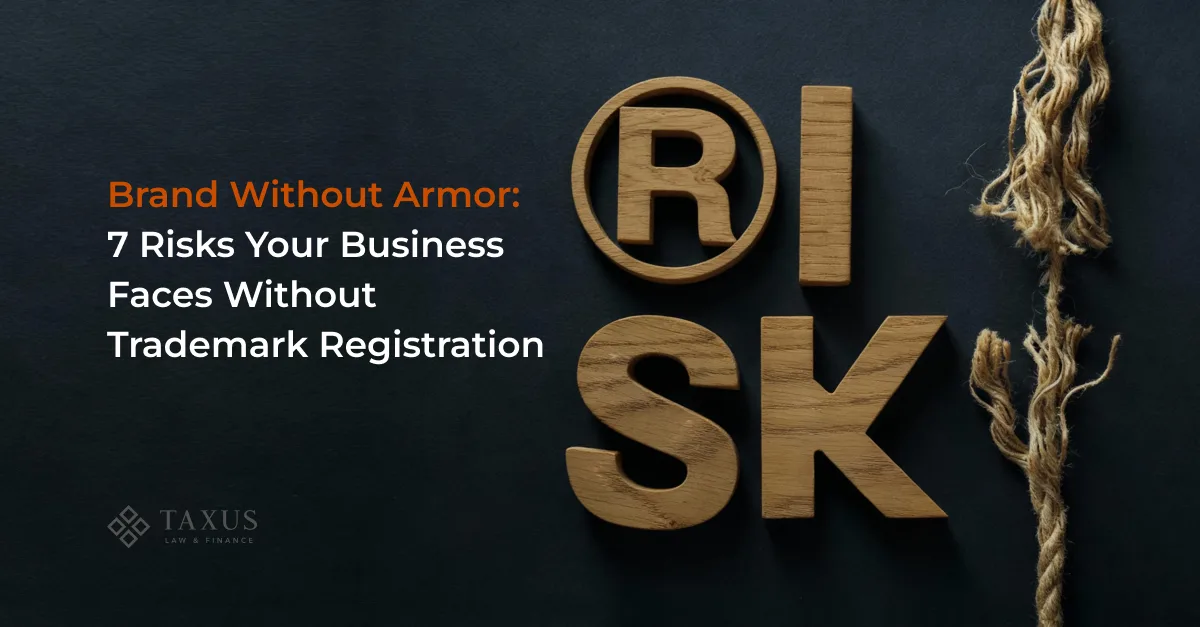Brand Without Armor: 7 Risks Your Business Faces Without Trademark Registration


In today’s globalized world, a brand is not just a name or logo – it is a valuable asset that builds customer trust and defines your market identity. However, not having a registered trademark (TM) in the European Union can lead to serious problems that threaten the existence of your business. From losing your domain name to lawsuits and forced rebranding, the risks are enormous and the consequences can be catastrophic. In this article, we will take a detailed look at the seven key risks associated with an unregistered TM, based on European legislation, and suggest four practical steps to help protect your brand.
What is a trademark and why is it “armor” for your brand?
A trademark (TM) is not just a logo or the name of your company. It is a legal tool that protects the uniqueness of your brand, ensures its recognition, and creates a strong connection with your customers. In the European Union, where market competition is extremely high, a TM acts as “armor” that protects your business from copying, fraud, and loss of reputation.
A trademark is a sign, symbol, word, or combination thereof that identifies the goods or services of a particular company and differs from those offered by competitors. In the European Union, trademarks are registered through the EUIPO (European Union Intellectual Property Office) and provide protection in all 27 EU member states. Unlike copyright (which protects original creative works such as books, music, or paintings) or patents (which protect inventions and technical solutions), a trademark focuses on protecting brand identity. For example, copyright will not save your logo from being copied by competitors, and a patent will not protect your product name from being used by others. Only a trademark guarantees that your brand will remain unique and inviolable.
Note:
Key differences:
Trademark – protects brand elements (names, logos, slogans) for goods or services.
Copyright – protects creative works, but not their commercial use as a brand.
Patent – protects technical innovations, but not product names or designs.
Trademarks in the EU can be diverse, as modern businesses use not only words or images, but also sounds, colors, and even movements. Below you can find the main types of trademarks that can be registered:
- Word mark. A word mark consists solely of words, letters, numbers, or other standard typographic characters, or any combination thereof.
- Figurative mark. Trademarks that use non-standard symbols, stylization or composition; graphic elements; or color. They may consist solely of figurative elements or a combination of word and figurative elements.
- Shape marks. A shape mark is a trademark consisting of a three-dimensional shape. It may relate to containers, packaging, the product itself, or its appearance.
- Position marks. Determined by the specific manner in which the mark is placed or applied to the product.
- Pattern marks. A pattern trademark consists exclusively of a set of elements that are repeated regularly.
- Color trademarks. Consists exclusively of a single color or combination of colors (without outlines).
- Sound marks. Consists exclusively of a sound or combination of sounds.
- Motion marks. Consists of the movement or change in position of the elements of the mark.
- Multimedia marks. A multimedia trademark consists of a combination of images and sound.
- Hologram marks. A hologram trademark consists of elements that have holographic properties.
| Type of TM | Example | Example Description |
| Word mark | Coca-Cola, Google | Brand name written in standard characters, protects textual identity. |
| Figurative mark | Nike logo (swoosh), Mercedes-Benz emblem | Graphic symbol or stylized design that visually identifies the brand. |
| Shape mark | Coca-Cola bottle, Lego figurine | Unique three-dimensional shape of a product or packaging associated with the brand. |
| Position mark | Red soles of Christian Louboutin shoes | Specific placement of an element (e.g., color or mark) on a product. |
| Pattern mark | Louis Vuitton Monogram pattern | Repeating decorative pattern associated with the brand. |
| Colour mark | Milka purple, Hermes orange | Protected shade or color combination that identifies the brand. |
| Sound mark | Nokia ringtone, MGM lion roar | Unique sound or melody associated with the brand. |
| Motion mark | Intel animated logo, Microsoft Windows startup animation | Animation or movement of elements that identify the brand. |
| Multimedia mark | Universal Pictures intro (globe and music) | Combination of image and sound to identify the brand. |
| Hologram mark | Hologram on Visa credit cards | Holographic effect used for protection and brand identification. |
Risks for business if you ignore trademark registration
In a world where your brand is the heart of your business, an unregistered trademark is like a house without a foundation: everything seems fine until a storm hits. Failure to register a trademark in the European Union can lead to serious threats that will jeopardize your finances, reputation, and even the existence of your company. From losing the right to use your brand to costly lawsuits, the risks are real and multifaceted. We will take a detailed look at seven key risks associated with delayed TM registration, backing them up with examples and references to European legislation. Learn how to protect your business before it’s too late!
Risk 1. Domain loss (cybersquatting).
Without a registered trademark, your brand remains vulnerable to cybersquatting—a practice where attackers register domain names that match or are similar to your brand name for profit (e.g., reselling the domain or using it to mislead consumers). Cybersquatting can lead to lost profits and threaten your brand’s reputation. But you can prevent this by registering your trademark. Article 4 of Regulation (EU) 2019/517 establishes a mechanism for protecting the rights of trademark owners in domain name disputes for .eu. It allows you to revoke or transfer a domain if it infringes on trademark rights and was registered without legal grounds or with malicious intent. This will be possible if you have a registered trademark and have filed a complaint through Alternative Dispute Resolution (ADR) or in court.
A good example of protection is the case of Beronata Services Ltd VS Andre Pasenih.
In 2019, the Cypriot company Beronata Services Ltd., owner of the BongaCams trademark, recovered the bongacams.eu domain through ADR. The domain was registered by an individual from Germany in 2012 and was used to redirect traffic to a third-party website, which misled consumers. The Arbitration Court (CAC) recognized the domain as identical to the trademark, established the absence of legal rights of the defendant and his bad faith intentions, and transferred the domain to the plaintiff.
Risk 2. Forced rebranding.
Article 8(4) of Regulation (EU) 2017/1001 plays a key role in protecting unregistered trademarks, but highlights the vulnerability of businesses that do not register their brands. According to this article, the owner of an unregistered trademark or other sign used in trade and having more than local significance may challenge the registration of a new trademark if they can prove that their rights arose earlier and that the national legislation of the EU country gives them the right to prohibit the use of similar signs. However, without a significant reputation or long-term use of an unregistered trademark, a business remains vulnerable: if another company registers your name as a trademark with the EUIPO, it will receive priority, which may force you to stop using the name and undergo expensive rebranding, as has happened in cases where small businesses have lost their brands due to a lack of legal protection.
A good example is the case of Lidl v. Tesco.
The plaintiff was Lidl, the owner of trademarks registered with the EUIPO (with a yellow circle on a blue square, both with and without text), covering classes of goods in the retail sector, while the defendant, Tesco, had been using a similar unregistered logo for its Clubcard Prices loyalty program since 2020, without having a trademark and without proving sufficient reputation or prior use for protection by analogy with Article 8(4) of Regulation (EU) 2017/1001; in April 2023, the UK High Court found Tesco guilty of infringing Lidl’s trademark, passing off, and partially infringing copyright, and on March 19, 2024, the Court of Appeal upheld the findings on the trademark and passing off, overturning only the copyright part, which led to mandatory rebranding of Tesco (replacement of the logo in marketing materials, applications, and signs) at a cost estimated at tens of thousands of pounds; the case demonstrates the importance of trademark registration, as even after Brexit, principles similar to Regulation (EU) 2017/1001 apply, and confirms the priority of registered rights over unregistered ones, which is of significant importance for practice in the EU.
Risk 3. Product removal from marketplaces.
On platforms such as Amazon EU, goods without a registered trademark may be blocked due to complaints of intellectual property rights violations, which is a common practice. Amazon has a strict intellectual property protection policy that allows rights holders to file complaints through the Brand Registry program or by reporting violations. Under Directive 2004/48/EC on the enforcement of intellectual property rights, rights holders can demand that marketplaces acting as intermediaries stop selling goods that infringe their rights. This directive provides for preliminary measures, such as blocking listings, and injunctions, forcing Amazon to respond quickly to complaints in order to avoid liability.
Risk 4. Legal disputes and infringement claims.
The use of an unregistered name in commercial activities may lead to serious legal consequences, including accusations of trademark infringement under Article 9 of Regulation (EU) 2017/1001. This article establishes the exclusive rights of registered trademark owners in the European Union and defines the conditions under which the use of similar signs may be considered an infringement. In particular, Article 9(2)(a) prohibits the use of signs that are identical or similar to a registered trademark if this could cause a likelihood of confusion among consumers. In addition, Article 9(2)(c) protects well-known trademarks from use that could damage their reputation or exploit their popularity for commercial purposes without permission.
A striking example is a case heard by the Court of Appeal of England and Wales, where Match Group, owner of the registered trademarks “MATCH.COM” and “MATCH,” filed a lawsuit against Muzmatch Ltd. The latter used the unregistered name “MUZMATCH” for its dating app targeting a Muslim audience. The court found that the use of the name “MUZMATCH” and related keywords in SEO optimization created a risk of confusion with the “MATCH” brand and unfairly exploited its reputation. In accordance with Articles 9(2)(a) and 9(2)(c) of Regulation (EU) 2017/1001, the court found an infringement, issued an injunction, and awarded damages.
Risk 5. Difficulty attracting investors.
Investors in the European Union increasingly consider the existence of a registered trademark as an important indicator of the protection of a company’s intellectual assets. According to Regulation (EU) 2017/1001, a registered trademark provides its owner with exclusive rights that allow them to protect the brand from unauthorized use and potential infringements. For investors, this is a guarantee of the stability and value of the brand, which increases the attractiveness of the company. The absence of a registered trademark, on the contrary, may signal risks associated with possible litigation or loss of market identity, which often leads to a lower valuation of the company.
From Idea to Trademark — Make It Official
Risk 6. Counterfeit products and reputational damage.
The absence of a registered trademark significantly complicates the protection of the brand from counterfeit products. Without registration, the owner does not have the exclusive rights provided for by Regulation (EU) 2017/1001, which complicates judicial or administrative measures against violators. Counterfeit products can easily enter the market, leading to a loss of brand reputation, reduced consumer confidence, and financial losses.
Regulation (EU) 608/2013 clearly establishes procedures for EU customs authorities to detain goods suspected of infringing intellectual property rights, including trademark rights. Article 2(7) of the Regulation defines “counterfeit goods” as goods that infringe the rights of a registered trademark. This means that customs authorities can only take action (detain, confiscate, or destroy goods) if there is a registered trademark entered in the customs database (AFA – Application for Action). Without a registered trademark, the owner cannot file an application with the customs authorities for protection.
Risk 7. Misleading “™” use.
Directive 2005/29/EC (Unfair Commercial Practices Directive, UCPD) prohibits commercial practices that mislead consumers.
Article 6 of the UCPD penalizes “misleading actions” — false or ambiguous statements, in particular regarding intellectual property rights and trademark status.
Article 7 of the UCPD prohibits “misleading omissions” — the concealment of important information.
The ™ symbol does not confirm registration. If its use creates the impression of an officially registered trademark, it may be considered a violation of both articles. EU member states impose fines and other sanctions for such actions. Businesses should clearly explain the status of a mark to avoid accusations of unfair practices.
How to minimize risks?
The absence of a registered trademark can lead to significant risks for a business, such as loss of brand rights, lawsuits from competitors, or use of the brand by third parties. These risks can undermine a company’s reputation and cause financial losses. One of the most effective ways to minimize such risks is to register a trademark in a timely manner.
First of all, it should be noted that small and medium-sized enterprises (SMEs) registered in the EU have a unique opportunity to take advantage of the SME Fund’s support to protect their intellectual property rights. This fund was created to help entrepreneurs ensure legal protection for their brands, in particular through trademark registration. By applying for a voucher from the SME Fund, companies can receive compensation of up to 75% of the costs associated with applying for trademark registration. This financial support lowers barriers for SMEs, allowing them to effectively protect their innovations and brands in the market, increasing competitiveness and ensuring stable growth. To take advantage of this opportunity, businesses need to familiarize themselves with the terms of the program and submit their applications on time.
It is important to note that registering a trademark through the European Intellectual Property Office (EUIPO) protects your brand in 27 EU countries. Below you can find out more about the registration process:
- Preliminary preparation for filing an application is important and consists of several stages. The first stage is to conduct a search via TMview to make sure that your trademark does not conflict with others. The second stage is to determine the classes. You need to select goods/services according to the Nice Classification via TMclass.
- After preparation, we can proceed directly to filing the application. To do this, you need to register on the EUIPO website, fill out an online form, specifying the type of trademark, description of goods/services, and adding images (if necessary), and pay the application fee.
- After submitting the application, EUIPO checks it for compliance with the requirements. If the application is completed correctly, it will be published in the bulletin, and within three months, owners of registered trademarks may file objections to your application if they believe their rights have been infringed. If there are no objections, the trademark will be registered within 4-6 months. You will receive a certificate upon registration.

Protect Your Brand Today
FAQ: Do I need a trademark?
Do I need a trademark?
A trademark protects your brand (name, logo, slogan, etc.) from being used by others, helps you stand out in the market, and builds customer trust. You need a trademark if:
- You want to protect your business identity in the EU.
- You plan to scale your business or sell goods/services in several countries.
- You want to avoid legal disputes over similar brands.
How long does registration take?
The trademark registration process usually takes 4-6 months if there are no objections. The stages include:
- EUIPO examination (formal and compliance).
- Publication of the application (3 months for objections).
- If there are objections or errors in the application, the process may be delayed.
How much does it cost?
You can calculate the cost for your case.
Can I register just a logo?
Yes, you can register only a logo as a figurative trademark. EUIPO allows you to register different types of trademarks.
Sources and References:
- Regulation (EU) 2019/517 — trademark owners’ rights in .eu domain disputes: https://eur-lex.europa.eu/legal-content/EN/TXT/?uri=CELEX%3A32019R0517
- Case Beronata Services Ltd vs Andre Pasenih — bongacams.eu domain decision: ADR.eu Decision
- Lidl v Tesco (UK, 2024): Court of Appeal Judgment, March 19, 2024
- Amazon EU Brand Registry policy: Amazon Help Center
- Match Group v Muzmatch Ltd (Court of Appeal, 2023): Bristows Judgment PDF
- Regulation (EU) 608/2013 — customs enforcement of IP rights: https://eur-lex.europa.eu/legal-content/EN/TXT/?uri=CELEX%3A32013R0608
- Directive 2005/29/EC — Unfair Commercial Practices (UCPD): https://eur-lex.europa.eu/legal-content/EN/TXT/?uri=CELEX%3A32005L0029
- EUIPO Fees Overview: EUIPO Official Fees

Looking for a reliable payment processing system?
Order selection of a payment solution.






